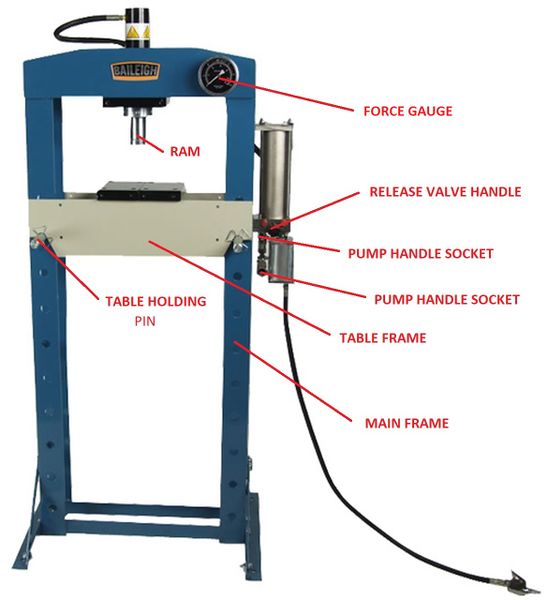Difference between revisions of "Hydraulic Press"
(→Safety) |
|||
| Line 66: | Line 66: | ||
==Safety== | ==Safety== | ||
| − | When operating a hydraulic press be aware that extremely dangerous forces | + | When operating a hydraulic press be aware that extremely dangerous forces can be produced which could cause parts to shatter and fly like bullets. It's very important to keep an eye on the force gauge while increasing force and to be aware of the dangers of flying parts. Always keep you hands away from the ram and parts being pressed. Keep stacked parts as short as possible to prevent tilting or buckling. If you have questions make sure to ask a supervisor prior to attempting something that could be potentially dangerous. Be aware that you may be working with heavy material located several feet above the floor and there is potential to drop metal on your feet. |
==Certification== | ==Certification== | ||
Revision as of 16:14, 15 April 2020
Make: Baileigh
Model: 30T Air Press
Ace: Nathan Hayward (nhayward21@georgefox.edu).
Location: Machine Shop
Description
A hydraulic press is a machine tool that uses a hydraulic cylinder to generate a compressive force. They are often used in shops to press interference fit parts together, such as gears onto shafts or bearings into housings. Some of the other uses include bending and forming metal. Some presses use a manual pump to produce the force while others use compressed air or a power unit driven by an electric motor.
Here is an example of this piece of equipment being used.
Documentation
Terminology
- Pressure Gauge- An indicator that uses a needle to indicate the amount of force being applied to the work piece.
- Release Valve Handle- This is the control handle for releasing the hydraulic pressure in the system. Turn the handle clockwise prior to charging the hydraulic system and counter-clockwise when releasing pressure.
- Table Holding Pin- 4 removable pins support the table and allow for height adjustment.
- Ram- This is is the end of the hydraulic cylinder rod that moves and pushes against your work piece.
- Pump Handle Socket- This is the location for handle placement while pumping up the hydraulic system.
Training
Overview
The hydraulic press has many uses including installation and removal of press fit parts as well as metal forming and punching. The press consists of a pump and hydraulic cylinder that moves down towards the table as the handle is cycled. As long as the cylinder moves the force will remain fairly low. When the cylinder stops moving the hydraulic pressure in the system will start to build. As the force increases so does the risk. Pieces that are subjected to a high amount of force can shatter or explode. Make sure you are aware of what is happening and don't keep pumping on the handle and increasing the force without knowing what is occurring.
Make sure you have a full understanding of what you are attempting to accomplish before attempting a risky situation. Ask a supervisor if you have any questions. Its important to properly set up the press before performing a job. When setting up the press, the table needs to be moved to the proper height to accommodate the work piece. You want to avoid extending the ram farther than needed to prevent material from tipping over. Always make sure you will have enough ram travel to perform the task at hand. The release valve handle will need to be turned fully clockwise to allow the system to build pressure. It is imperative that you keep the work piece from tipping or slipping to the side while applying force. You should use a guide when pressing in a pin to prevent the pin or rod from slipping while installation. Keep an eye on the force gauge to verify your work piece is not sticking or hanging up. When the piece is pressed to its maximum travel pressure will start to build and could cause damage if you keep cycling the handle. Be aware of when you part bottoms out and avoid applying more force at the end of your parts travel than needed.
Demonstration
Insert text
General Procedure
Safety
When operating a hydraulic press be aware that extremely dangerous forces can be produced which could cause parts to shatter and fly like bullets. It's very important to keep an eye on the force gauge while increasing force and to be aware of the dangers of flying parts. Always keep you hands away from the ram and parts being pressed. Keep stacked parts as short as possible to prevent tilting or buckling. If you have questions make sure to ask a supervisor prior to attempting something that could be potentially dangerous. Be aware that you may be working with heavy material located several feet above the floor and there is potential to drop metal on your feet.
Certification
Foxtale Quiz
Troubleshooting
If you pump the handle and the ram doesn't move try tightening the release valve knob.
Maintenance
General maintenance
Keep the press clean. The hydraulic oil level and hoses should be checked by the tech on a regular basis.
Specific Maintenance Tasks
| Maintenance Procedure | Frequency | Done By |
|---|---|---|
| Sample | Sample | Sample |

